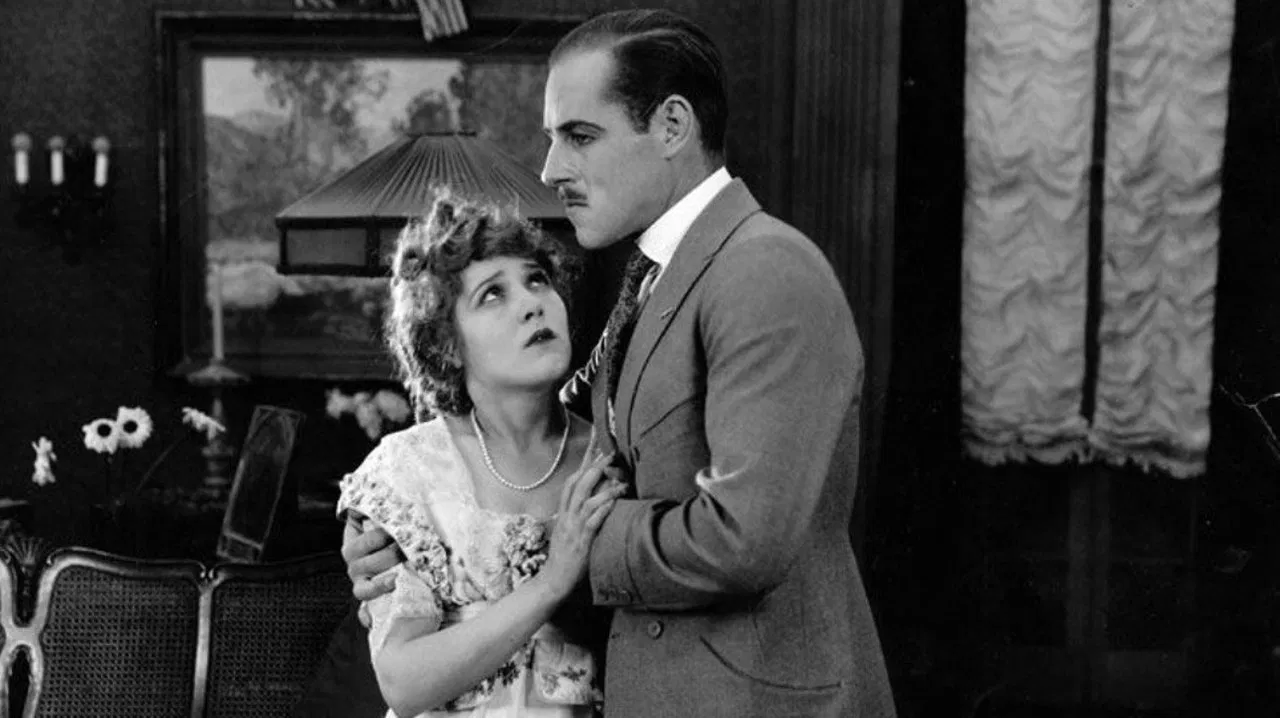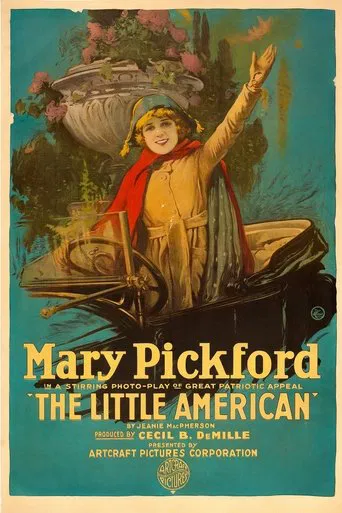

You'd think after over 90 years have passed, this little WWI propaganda would be rendered a creaky, laughable history piece. The Little American, however, remains a powerful work of melodrama, mainly due to the talents of its star, Mary Pickford.Pickford plays Angela Moore, the titular 'Little American', who's the center of a love triangle between a German-American (Jack Holt) and a French-American (Raymond Hatton). WWI breaks out, however, and Angela's suitors are called back to their home countries to serve in their nation's respective armies. Shortly after, Angela leaves for France to visit an aunt, but while en route a German U-boat sinks the ship she's on. She manages to survive though, and makes it to her destination only to discover her aunt has passed and the Germans are close to occupying the town. Being the plucky, kind-hearted gal she is, Angela houses wounded French soldiers in her newly inherited château and even acts as a spy for the French army. Things become even more complex when the Germans occupy the house and Angela encounters her old German beau, who almost forces himself upon her before realizing who she is. He becomes torn by love and duty, but willingly submits to the former once Angela is found out as a spy.Mary Pickford is a joy to watch. She takes a typical plucky young woman role and plays it with such charm that you just fall in love with her. Her style is naturalistic, making her stand out from most other early silent film actors, who tended to utilize broad, exaggerated gestures from the stage. This is the first time I've seen her acting, and I'm definitely planning on seeing more of her work in the future.Unlike Mary's acting, the story itself rarely utilizes subtlety. Angela's patriotic fervor is made obvious from the beginning: she was born on the Fourth of July, and carries a small American flag around with her throughout the majority of the picture. Later on, when Pickford and Hoft caught in the crossfire of a battle, they find refuge beneath a large crucifix, which manages to remain standing even as the rest of the church it was in crumbles to nothing. As is to be expected of propaganda, aside from Pickford's German lover, the Germans are depicted as heartless monsters who rape, murder, and kick puppies at the slightest whim. Due to the charm of Pickford and the great chemistry her character shares with Hoft's, you truly grow to despise the "Huns" as the film progresses; it's mind-blowing to think that during the picture's first release that aspect must have been a great driving force in getting men to run out and sign up for the war.If you're a silent buff, Pickford fan, or interested in WWI, then you should definitely give The Little American a look. It's a well-crafted piece of propaganda sporting not also historical value but a decent story and the charismatic presence of America's Sweetheart.
... View MoreCanadian actress Mary Pickford plays lead in "The Little American"--one of the most blatant examples of anti-German propaganda made during WWI.The film begins with Mary being courted by a German guy (Jack Holt). However, before they can marry, he's called back to serve in the German army, as WWI has just begun (incidentally, the US stayed out of the war for more than 2 1/2 years). Shortly after this, Mary is called to France, as a rich relative has requested she come there. On the way, the passenger ship she is on is torpedoed--much like the famous Lusitania case (her ship is called the 'Veritania'--subtle, huh?). It's ridiculous today to see German soldiers (including Holt) toasting to the sinking of a passenger ship, but back in 1917, the public ate this up and believed it to be true (now we know these accounts were fabricated by the British government).Despite her boat being torpedoed, plucky Mary makes it to France where she learns that she's just inherited the Aunt's estate. However, soon the Germans come and attack her in her new home. Despite telling them she's an American (who were at the time Neutral), they attack with the ferocity of hungry dogs going after a pork chop! Now the Germans occupy her home and the Germans ignore her pleas to spare the French civilians. Instead, she's made a virtual slave in her own home--waiting on the Germans as they destroy her home. In one of those coincidences that can only happen in a movie, Holt is naturally there as well but does nothing to help her or her new people. In the meantime, the Germans start executing civilians and behaving horribly.As a result of the German atrocities, Mary feels she has no choice but to aid the French army--directing fire upon her estate. She knows it might mean death for her, but she is now committed to the Allied cause. When she is captured, "America's Sweetheart" (a title bestowed on the actress) is threatened with execution!! At this point, Holt announces he'd rather die with her than serve the accursed Kaiser! But, in a scene once again only found in movies, the two are saved at the instant before the Germans open fire on them!! The final scenes show the Germans reducing a church to rubble all around a lone crucifix! Wow, subtle it ain't!! At the time this was made, I am sure it was super-effective in galvanizing people behind the Allied war effort. Even though in 1916 almost all Americans were in favor of continued neutrality, by April 1917 (when the US entered the war), Americans went war-crazy--eating up films like this, growing Victory Gardens, volunteering to fight, beating up German-Americans and getting jobs in munitions plants. All this for a war that had no real good guys or bad guys--just millions and millions dead. Because this movie made this seem GOOD, it left me a bit unsettled. However, it is well made and effective.
... View MoreWhen the US entered World War I, the government forced Hollywood to churn out propaganda films. THE LITTLE American is probably the best of the lot because it stars Mary Pickford.Pickford plays a young woman torn between two men: Jack Holt (German) and Raymond Hatton (French), but her decision is delayed because of the war as both men enlist.When the ship Pickford is sailing on is sunk by the Germans (think Lusitania) because it is carrying munitions, Pickford has a great scene as she stands on the lifeboat and yells at the German commander. Later on, of course, she runs into both Holt and Hatton when she is being held as a war prisoner at a château.Director Cecil B. DeMille provides one truly great scene in this film as Pickford and Holt are wandering through a bombed-out village. They pass a destroyed church of which only one wall remains standing. Against the wall is a very large crucifix. As they stand and watch, the wall collapses but the Jesus figure remains, suspended in mid air. It's a very surreal moment in a film that is otherwise very straightforward and un-artsy.Pickford is, as always, a pleasure to watch. She was always a very natural actress who avoided the arm-waving histrionics many other actors of the day used. She's also very very pretty. Holt is very good here in a leading-man role. Hatton is OK. Among the list of name actors in "extra" parts are Wallace Beery, Ramon Novarro, Colleen Moore, Ben Alexander, Hobart Bosworth, Norman Kerry, Walter Long, James Neill, and Edythe Chapman.Not a great film, but interesting to see US propaganda at work.
... View MoreIn its own time, this effective and often compelling wartime melodrama used the talents of Mary Pickford and a young Cecil B. DeMille in support of the Allies in the first world war. It works well in itself, and it might be even more worthwhile now, for a generation that can view the events of that era more impartially, in order to draw some broader lessons from it.Pickford plays Angela, "The Little American", a young woman courted by a German and a Frenchman who are both living in America. This familiar setup soon becomes much more serious when the war breaks out, and the two young men return to Europe and the battlefield, with Pickford's character soon joining them in the midst of the turmoil and terror of the conflict. The ensuing story occasionally has some points in common with the Valentino/Rex Ingram classic "The Four Horsemen of the Apocalypse", though with a generally more hopeful tone.The first half has a particularly excellent sequence that depicts a submarine attacking a passenger liner. It works very well both dramatically and thematically. In particular, the light and motion of the sub's searchlight darting erratically through the darkness, so that its crew can survey the results of their attack, produces a chilling effect that is probably more effective than any amount of screaming could have been. The sequence works convincingly in portraying the barbarous, inhuman nature of attacks on civilian targets, and it also demonstrates the emptiness of the excuses used to justify them.That is probably the strongest sequence, but the main story in the château also has some worthwhile material. The German soldiers are largely portrayed as subhuman, but this is balanced to a large degree by the character of Karl (Jack Holt) and his inner struggle between his sense of duty and his sense of justice. Holt and Pickford work well together, and Raymond Hatton, though not getting as much screen time, also makes good use of his opportunities.With the delightful Pickford as the star, and DeMille already showing his ability to film set pieces effectively, this must have been very persuasive in its original purpose of strengthening support for the Allied cause. But now it can serve a different, and possibly more important, purpose. The harrowing experiences of Angela and the other characters are effective in demonstrating how quickly the fabric of human society can tear apart when military victory becomes all-important. While less ambitious and less well-known than the best-known of the classic movies that came out of the first world war, "The Little American" works well, and it is well worth the time to watch.
... View More